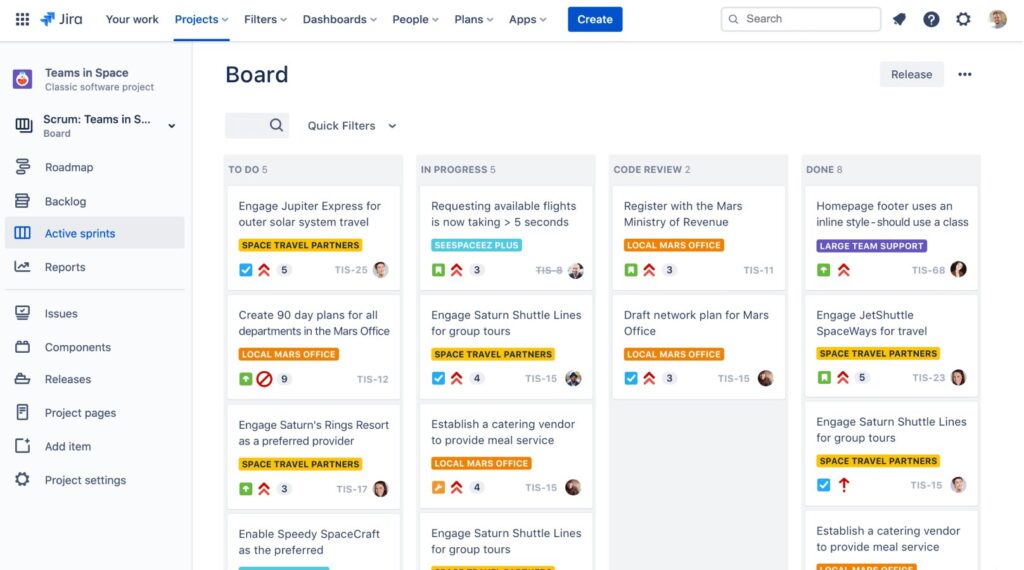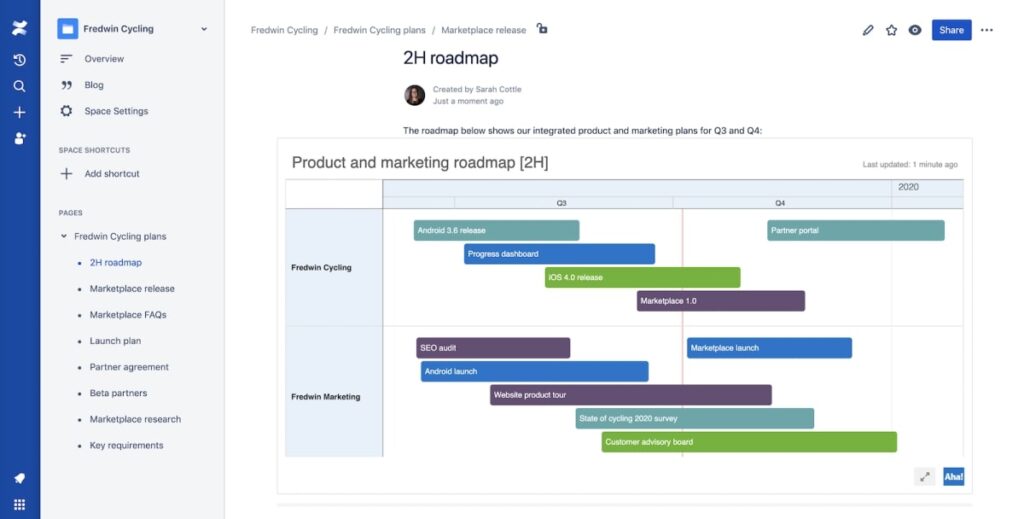What is Jira? What is Confluence? And how do they match up against each other in Scrum?
Software development is moving forward in leaps and bounds. Two of the best collaboration tools for software development are Jira and Confluence, members of the Atlassian suite of products.
Comparing Jira vs. Confluence is similar to comparing apples and oranges since they are two different tools.
In this article, we break down the differences between Confluence and Jira. We also discuss which one best serves the Scrum process better in your company or whether you need a different type of solution.
To learn more via video, watch below. Otherwise, skip ahead.
What is Jira?
Jira Software is a job or issue-tracking software tool designed to assist business teams with the planning, tracking, and releasing of software. Jira software allows the team to create, update, and organize any issues that arise.

Credits: Jira
It allows you to define user stories, plan sprints, and organize and prioritize your backlog. Jira is best for complex and large software development projects. It has many features and offers an extensive range of customizable templates, and non-technical teams find Jira too complicated.
What is Confluence?
Confluence is a software tool that allows your business teams to create, collaborate, and do all their organizing in one place.

Credits: Aha.io
While Confluence served as a software corroboration tool in its initial conception, it’s an across-the-board all-purpose software solution that serves several scenarios. Companies use Confluence to set up knowledge domains, create employee manuals, collaborate on documents and meeting summaries, and more.
Smaller teams use Confluence for design documents and project-based planning, with no need for a specialized job-tracking tool like Jira.
While Jira offers a variety of custom features, including Kanban board, roadmaps, timelines, and more, some teams have little use for these extras, depending on the size of the project.
The Scrum Process
Even if you’re familiar with the Scrum technique, it’s helpful to summarize the Scrum process. Scrum is an Agile project management technique involving a small team whose job is to attain a specific goal.
The Scrum is the series of meetings, the delegation of project tasks, troubleshooting, and sharing of ideas that the collaboration unit uses as a framework and building tool to help manage data and task completion. Teams learn to be more efficient by collecting and comparing data and the time taken to complete similar tasks.
Advantages of Using Jira
Jira is an excellent tool for project management and project documentation. It provides a customizable platform for your teams to participate in a Scrum. Many units create their tasks or Jira issues and direct their workflow through this platform.
A Jira project contains all your project documentation and meeting notes so that it’s easy to track issues and assign tasks to the relevant Agile teams involved.
Jira, rated as the number 2 Scrum tool by Capterra (with a rating of 4.4 out of 5 stars), is a powerful collaboration tool to have in a company.
To sum up, Jira project management software is a tracking tool that uses Agile methodologies to deliver faster, and it comes with Scrum and Kanban Board templates.
Advantages of Using Confluence
Confluence also has a rating of 4.4 stars by Capterra as a Knowledge Management Software Tool. Confluence ensures that your team is all on the same page and all have the same information for a project. It also provides a single source that contains all the updated and collected information so far for the successful completion of your project.
Differences Between Jira and Confluence
Both Jira and Confluence are collaboration tools, but when it comes down to the crunch, Confluence works better with long-form content, while Jira handles structured data better.
What works well for many business teams is to create Jira issues on Confluence pages and integrate the two software tools for maximum output efficiency.
Let’s dive deeper into a few of the features that a scrum might use.
Jira vs Confluence in Scrum: Does it Matter?
Both Jira and Confluence are Atlassian products. The good thing about these two products is that one uses them independently or together to optimize collaboration and save time.
In a company with more than one unit, it’s best to use both Jira and Confluence to manage projects and keep track of the overall progress of each of your Scrum teams.
But let’s say you are only using one of these Atlassian products. Let’s dive in together and see the advantages and disadvantages of using each software program in a Scrum. Or is the best solution for you to integrate Jira and Confluence?
Let’s get into it and evaluate what the other differences are.
Access Control
I do not believe access control is essential in a Scrum. It’s enough that everyone in a team knows the overall goal of the team’s efforts, so either one of these works. However, use Confluence to grant limited access to certain people for specific documents, among others. This is because Jira does not support Access Control, whereas Confluence does.
With Jira, everyone in the team has equal access to all documentation regarding a particular issue. There are no security options or different levels of access with Jira.
Action Management
Action management is about starting a job and getting it done, and it is about knowing which efforts and outcomes are essential and working with up-to-date sources to achieve results in line with the aim of the company. This is all the more important in a large company with many projects and sources.
In the case of large projects, I recommend either using Jira or integrating Confluence and Jira to ensure maximum efficiency.
Application Integration
Suppose you need to download from or upload to other apps for information for your Scrum or during your Scrum. In that case, Jira is the better choice because it supports application integration, whereas Confluence does not.
More significant projects benefit more from Jira, whereas a smaller project does need application integration.
Assignment Management
This is the process where the project manager schedules tasks and assigns them to the respective members of the development team. This includes ensuring that the group meets deadlines and that the results are of acceptable quality.
Jira supports Assignment Management, whereas Confluence does not. If Assignment Management is an integral part of your Scrum, use Jira or create Jira issues on Confluence pages and integrate the two. Using these two powerful tools together works wonders.
Budget Management
Jira does not support Budget Management. Create the Jira issues in Confluence and do your budget management from Confluence, which requires integrating the two software tools.
Calendar Management
Calendar management is an organized process for scheduling meetings, duties, and tasks to maximize your production efficiency.
Jira does not offer Calendar Management. Therefore, my recommendation is to create the issues on Confluence pages and integrate the two.
Content Management
The daily Scrum is an integral part of Agile Content Management. That said, Jira does not support content management and also does not offer real-time editing.
Using Jira for your Scrum involves more work than using Confluence, as the team members have to go back into the ticket to add content instead of typing it in real-time, like with Confluence.
If you add a lot of content during your Scrum, I recommend using Confluence to create your Jira software project and directing your Jira workflow using the relevant Confluence page.
Directory Integration
Jira supports directory integration, but Confluence does not.
Document Management
Confluence supports document management, but Jira does not.
Dynamic Workflow
Where workflows are a direct and preplanned sequence of tasks set up by a project manager or someone within the company, a dynamic workflow adapts to fluid situations in the business process.
If your company tasks work with dynamic workflow, then Jira is the better software to use as it supports Dynamic Workflow, while Confluence is better for a linear workflow.
Again, in a small company, where everyone has their designated duties and tasks, and a reallocation of responsibilities is not likely to occur, Confluence is sufficient.
In a large company whose staff finds that reallocation is necessary for maximum positive outcome effect, then Jira is the better software tool to choose.
Project Plan
Project Plan is not one of Jira’s features, but it is available with Confluence.
Project Time Tracking
Jira uses the Harvest Time Tracking Tool, whereas Confluence needs an add-on time tracker. With Confluence, switching context and tracking time on the Jira platform is possible. Installing an add-on time tracker to Confluence is helpful in this case.
Since everyone sees the input of other individuals on the same team, time tracking inspires members to keep an eye on each other and motivates them to friendly competition, driving each group member to do their utmost best not to appear less productive than others.
Time tracking is imperative if you have a team working on similar tasks. This helps you see who takes the most extended amount of time to get a specific job done and allows you to rearrange the team for absolute maximum efficiency.
I recommend Jira if time tracking is an essential part of your scrum.
Real-Time Editing
Real-time editing is sometimes essential, especially in dynamic workflow in a fast-paced company. While Confluence offers real-time editing, Jira, unfortunately, does not.
Suppose your Scrum involves a lot of task-shifting and new information with more technical points raised during a meeting. In that case, the danger is that these developments get lost as they aren’t captured on the spot, and often the developer forgets to go back into the ticket after the meeting to add his point.
Collaborative editing in Confluence takes teamwork to the next level by letting you and your team work together in real-time on requirements, meeting transcripts, documents, and anything else on your Confluence pages.
For this reason alone, I handle each Scrum as a separate Confluence page. While creating Jira issues for each of the major points raised, open Confluence pages as ‘sub-tasks or issues; each with its list of instructions or delegated jobs.
With Confluence, you see who’s editing the page with you and the changes as team members enter them. If someone in the team makes changes, the rest of the team sees them straight away in real time.
This ups the pace of the process and makes it much easier for the team to work like a well-oiled machine.
Reports and Statistics
Reports like the velocity report, are essential to a Scrum. Jira supports Reports and Statistics, but Confluence does not.
If you have a large team and need to keep close track of how long tasks take each team member, you need to print out a velocity report for maximum productivity.
Project Workflow
Project workflow is available with Jira but not with Confluence. Each company’s and team’s needs are different, and Jira supports more complex issues, whereas Confluence is better for more straightforward matters.
Jira vs Confluence: Key Takeaways
My advice is to go for the Jira and Confluence Combo, but as you see from the reviews above, both have strong usage benefits, although teams prefer Jira.
The key is to know which one or combination of solutions is best for you and your team’s specific needs. That way, it gets easier to plan as a team and manage workflows.
Whichever one you decide to go with, happy scrumming.
